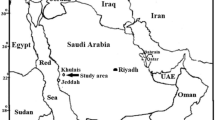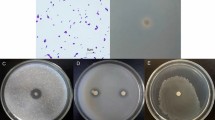Abstract
Microbe-assisted phytoremediation has great potential for practical applications. Plant growth-promoting bacteria (PGPB) with heavy metal (HM) resistance are important for the implementation of PGPB-assisted phytoremediation of HM-contaminated environments. Arthrobacter sp. PGP41 is a Cd(II)-resistant bacterium isolated from the rhizosphere soils of a Cd(II) hyperaccumulator plant, Solanum nigrum. Strain PGP41 can significantly improve plant seedling and root growth under Cd(II) stress conditions. This bacterium exhibited the ability to produce high levels of indole-3-acetic acid (IAA), as well as the ability to fix nitrogen and solubilize phosphate, and it possessed 1-aminocyclopropane-1-carboxylate (ACC) deaminase activity. Here, we present the complete genome sequence of strain PGP41. The genome consists of a single chromosome with a G+C content of 65.38% and no plasmids. The genome encodes 3898 genes and contains 49 tRNA and 12 rRNA genes. Multiple genes associated with plant growth promotion were identified in the genome. The whole genome sequence of PGP41 provides information useful for further clarifying the molecular mechanisms behind plant growth promotion by PGPB and facilitates its potential use as an inoculum in the bioremediation of HM-contaminated environments.






Similar content being viewed by others
References
Meij R, Winkel HT (2007) The emissions of heavy metals and persistent organic pollutants from modern coal-fired power stations. Atmos Environ 41:9262–9272
Kasassi A, Rakimbei P, Karagiannidis A, Zabaniotou A, Tsiouvaras K, Nastis A, Tzafeiropoulou K (2008) Soil contamination by heavy metals: measurements from a closed unlined landfill. Bioresour Technol 99:8578–8584
De Filippis L, Pallaghy C (1994) Heavy metals: sources and biological effects. In: Rai LC, Gaur JP, Soeder CJ (eds) Algae and water pollution E. Schweizerbart’sche. Verlagsbuchhandlung, Stuttgart, pp 31–77
Cervantes C, Gutierrez-Corona F (1994) Copper resistance mechanisms in bacteria and fungi. FEMS Microbiol Rev 14:121–138
Paulino AT, Minasse FA, Guilherme MR, Reis AV, Muniz EC, Nozaki J (2006) Novel adsorbent based on silkworm chrysalides for removal of heavy metals from wastewaters. J Colloid Interface Sci 301:479–487
Santos J, Almeida SFP, Figueira E (2013) Cadmium chelation by frustulins: a novel metal tolerance mechanism in Nitzschia palea (Kützing) W. Smith. Ecotoxicology 22:166–173
Fu F, Wang Q (2011) Removal of heavy metal ions from wastewaters: a review. J Environ Manage 92:407–418
Marques AP, Rangel AO, Castro PM (2009) Remediation of heavy metal contaminated soils: phytoremediation as a potentially promising clean-up technology. Crit Rev Environ Sci Technol 39:622–654
Yao Z, Li J, Xie H, Yu C (2012) Review on remediation technologies of soil contaminated by heavy metals. Procedia Environ Sci 16:722–729
Atlas RM, Bartha R (1997) Microbial ecology: fundamentals and applications. Benjamin/Cummings Science, New York
Chen H, Yang B, Chen X (2009) Identification and characterization of four strains of Acidithiobacillus ferrooxidans isolated from different sites in China. Microbiol Res 164:613–623
Bhattacharya A, Gupta A (2013) Evaluation of Acinetobacter sp. B9 for Cr (VI) resistance and detoxification with potential application in bioremediation of heavy-metals-rich industrial wastewater. Environ Sci Pollut Res Int 20:6628–6637
Glick BR (2010) Using soil bacteria to facilitate phytoremediation. Biotechnol Adv 28:367–374
Ma Y, Prasad MN, Rajkumar M, Freitas H (2011) Plant growth promoting rhizobacteria and endophytes accelerate phytoremediation of metalliferous soils. Biotechnol Adv 29:248–258
Welbaum GE, Sturz AV, Dong Z, Nowak J (2004) Managing soil microorganisms to improve productivity of agro-ecosystems. Crit Rev Plant Sci 23:175–193
Grčman H, Velikonja-Bolta Š, Vodnik D, Kos B, Leštan D (2001) EDTA enhanced heavy metal phytoextraction: metal accumulation, leaching and toxicity. Plant Soil 235:105–114
Hassan W, Bano R, Bashir F, David J (2014) Comparative effectiveness of ACC-deaminase and/or nitrogen-fixing rhizobacteria in promotion of maize (Zea mays L.) growth under lead pollution. Environ Sci Pollut Res Int 21:10983–10896
Navarro-Torre S, Mateos-Naranjo E, Caviedes MA, Pajuelo E, Rodríguez-Llorente ID (2016) Isolation of plant-growth-promoting and metal-resistant cultivable bacteria from Arthrocnemum macrostachyum, in the Odiel marshes with potential use in phytoremediation. Mar Pollut Bull 110:133–142
Gordon SA, Weber RP (1951) Colorimetric estimation of indoleacetic acid. Plant Physiol 26:192–195
Tamura K, Stecher G, Peterson D, Filipski A, Kumar S (2013) MEGA6: molecular evolutionary genetics analysis version 6.0. Mol Biol Evol 30:2725–2729
Darriba D, Taboada GL, Doallo R, Posada D (2012) jModelTest 2: more models, new heuristics and parallel computing. Nat Methods 9:772–772
Li R, Yu C, Li Y, Lam TW, Yiu SM, Kristiansen K, Wang J (2009) SOAP2: an improved ultrafast tool for short read alignment. Bioinformatics 25:1966–1967
Chaisson MJ, Tesler G (2012) Mapping single molecule sequencing reads using basic local alignment with successive refinement (BLASR): application and theory. BMC Bioinformatics 13:238
Myers EW, Sutton GG, Delcher AL, Dew IM, Fasulo DP, Flanigan MJ, Kravitz SA, Mobarry CM, Reinert KH, Remington KA, Anson EL, Bolanos RA, Chou HH, Jordan CM, Halpern AL, Lonardi S, Beasley EM, Brandon RC, Chen L, Dunn PJ, Lai Z, Liang Y, Nusskern DR, Zhan M, Zhang Q, Zheng X, Rubin GM, Adams MD, Venter JC (2000) A whole-genome assembly of Drosophila. Science 287:2196–2204
Huang Y, Gilna P, Li W (2009) Identification of ribosomal RNA genes in metagenomic fragments. Bioinformatics 25:1338–1340
Lowe TM, Eddy SR (1997) tRNAscan-SE: a program for improved detection of transfer RNA genes in genomic sequence. Nucleic Acids Res 25:955–964
Delcher AL, Harmon D, Kasif S, White O, Salzberg SL (1999) Improved microbial gene identification with GLIMMER. Nucleic Acids Res 27:4636–4641
Darling AE, Mau B, Blatter FR, Perna NT (2004) Mauve: multiple alignment of conserved genomic sequence with rearrangements. Genome Res 14(7):1394–1403
Darling AE, Mau B, Perna NT (2010) progressiveMauve: multiple genome alignment with gene gain, loss, and rearrangement. PLoS ONE 5(6):e11147
Ryu CM, Farag MA, Hu CH, Reddy MS, Wei HX, Paré PW, Kloepper JW (2003) Bacterial volatiles promote growth in Arabidopsis. Proc Natl Acad Sci USA 100:4927–4932
Vessey JK (2003) Plant growth promoting rhizobacteria as biofertilizers. Plant Soil 255:571–586
Glick BR, Cheng Z, Czarny J, Duan J (2007) Promotion of plant growth by ACC deaminase-producing soil bacteria. Eur J Plant Pathol 119:329–339
Belimov AA, Safronova VI, Sergeyeva TA, Egorova TN, Matveyeva VA, Tsyganov VE, Borisov AY, Tikhonovich IA, Kluge C, Preisfeld A, Dietz KJ, Stepanok VV (2001) Characterization of plant growth promoting rhizobacteria isolated from polluted soils and containing 1-aminocyclopropane-1-carboxylate deaminase. Can J Microbiol 47:642–652
Jones DL (1998) Organic acids in the rhizosphere—a critical review. Plant Soil 205:25–44
Chen YX, Lin Q, Luo YM, He YF, Zhen SJ, Yu YL, Tian GM, Wong MH (2003) The role of citric acid on the phytoremediation of heavy metal contaminated soil. Chemosphere 50:807–811
Rodríguez H, Fraga R (1999) Phosphate solubilizing bacteria and their role in plant growth promotion. Biotechnol Adv 17:319–339
Malboobi AOP, Behbahani M, Sarokhani E, Moradi S, Yakhchali B, Deljou A (2009) Solubilization of organic and inorganic phosphates by three highly efficient soil bacterial isolates. World J Microbiol Biotechnol 25:1471–1477
Haas D, Keel C (2003) Regulation of antibiotic production in root-colonizing Pseudomonas spp. and relevance for biological control of plant disease. Annu Rev Phytopathol 41:117–153
Taghavi S, van der Lelie D, Hoffman A, Zhang YB, Walla MD, Vangronsveld J, Newman L, Monchy S (2010) Genome sequence of the plant growth promoting endophytic bacterium Enterobacter sp. 638. PLoS Genet 6:e1000943
Chen Y, Shen X, Peng H, Hu H, Wang W, Zhang X (2015) Comparative genomic analysis and phenazine production of Pseudomonas chlororaphis, a plant growth-promoting rhizobacterium. Genom Data 4:33–42
Zhou C, Ma Z, Zhu L, Xiao X, Xie Y, Zhu J, Wang J (2016) Rhizobacterial strain Bacillus megaterium BOFC15 induces cellular polyamine changes that improve plant growth and drought resistance. Int J Mol Sci 17:976
El-Tarabily KA, Sivasithamparam K (2006) Non-streptomycete actinomycetes as biocontrol agents of soil-borne fungal plant pathogens and as plant growth promoters. Soil Biol Biochem 38:1505–1520
Acknowledgements
This work was funded by the Fundamental Research Funds for the Central Universities (KJQN201532 and KJQN201641), the National Key Research and Development Program of China (2016YFD0800803), the National Natural Science Foundation of China (31770404), China Postdoctoral Science Foundation (2016T90468), and the Science Foundation of Jiangsu Province, China (BK20150670).
Author information
Authors and Affiliations
Corresponding author
Ethics declarations
Conflict of Interest
The authors declare that they have no conflict of interest.
Rights and permissions
About this article
Cite this article
Xu, X., Xu, M., Zhao, Q. et al. Complete Genome Sequence of Cd(II)-Resistant Arthrobacter sp. PGP41, a Plant Growth-Promoting Bacterium with Potential in Microbe-Assisted Phytoremediation. Curr Microbiol 75, 1231–1239 (2018). https://doi.org/10.1007/s00284-018-1515-z
Received:
Accepted:
Published:
Issue Date:
DOI: https://doi.org/10.1007/s00284-018-1515-z




